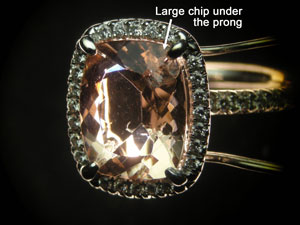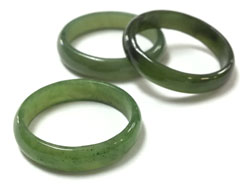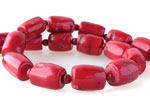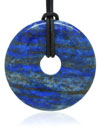Do genuine gemstones break?
 On one of those internet forums where people ask questions and exchange experiences, one writer asked whether her necklace had fake gems because when she dropped it on the floor one of the stones broke.
On one of those internet forums where people ask questions and exchange experiences, one writer asked whether her necklace had fake gems because when she dropped it on the floor one of the stones broke.
Several people favored the buyer and suggested she ask the seller for a refund.
But no! A broken stone does not mean this consumer was snookered into buying fake merchandise. Gems can break—and some gems break or chip or fracture or become scratched more readily than others. That's important information for insurers to know.
A morganite story
 One insurer received a claim on a morganite engagement ring with a chipped stone. The chip was under one of the prongs. Close examination revealed that the prong itself was bent, suggesting that whatever force had bent the prong had also chipped the stone.
One insurer received a claim on a morganite engagement ring with a chipped stone. The chip was under one of the prongs. Close examination revealed that the prong itself was bent, suggesting that whatever force had bent the prong had also chipped the stone.
The insurer was able to locate a replacement stone of similar proportions but slightly larger. In setting the new stone, the cutter chipped it. The insurer was left with the additional cost of having the replacement stone recut to remove the chip and restore a symmetrical appearance.
 This experience shows the relative fragility of morganite. Morganite's rich shades of pink, rose, salmon, and purple make an attractive engagement ring, but the stone's wearability does not.
This experience shows the relative fragility of morganite. Morganite's rich shades of pink, rose, salmon, and purple make an attractive engagement ring, but the stone's wearability does not.
The cleavage planes of morganite are such that the stone will split fairly easily if struck from the right angle. It is a fairly "soft" gem, much "softer" than diamond, meaning that it is vulnerable to scratches and dings, which dull the surface of the stone. This is normal wear and tear for this stone, not damage for which the insurer is liable.
Morganite is a lovely stone for earrings or a pendant or a special-occasion ring; it's not a good choice for a ring worn every day and subjected to all sorts of activities and environments. One jeweler said that, in a ring for daily wear, one should expect to replace morganite every few years.
A stone's susceptibility to scratching and chipping could be considered inherent vice, so the insurer would not be responsible for damage to the stone in a ring worn every day.
It turned out that this insured had even been warned of morganite's fragility at time of purchase. Since this was one item on a large schedule, the insurer decided to cover the claim but advised the insured that any future damage of this type would not be covered because the stone's fragility constitutes inherent vice.
Gems and their vulnerabilities
Hardness and toughness are used to describe the fragility of gems, but don't confuse those terms. Hardness is the gem's ability to resist scratching; toughness is the ability to resist breakage from a blow.
Diamond, the hardest gem, can be scratched only by another diamond, but it's toughness is not great. Diamond can be chipped fairly easily — as many adjusters can attest.
Jade, on the other hand, has a low hardness rating but an excellent toughness rating. This material is "soft" enough to be carved into very fine detail, but tough enough to be resistant to breakage. A simple circle carved from jade makes a very durable ring. You could never do that with diamond!
Many beautiful gems rate low in either hardness or toughness, or both. They are fine in earrings or a necklace, or in a ring worn only on special occasions, but they are poor choices for rings or bracelets exposed to daily activities and chores.
|
Coral |
Lapis lazuli |
Pearl |
Amber |
Opal |
Opal, for example, is very susceptible to changes in temperature. Pearls are easily scratched by normal wear and tear. Kunzite, which comes in delicate shades of pinks and purples, is known as an "evening stone" because its colors fade on exposure to sunlight. Amber is soft, coral can be eaten away by chemicals and body acids, cameos made of shell may discolor over time, etc. Such changes are due to inherent vice.
Many gems react adversely to common household chemicals. Improper cleaning or pressure during setting can permanently damage some stones. A jeweler's torch can cause discoloring or cracking in some gems and may even cause turquoise to explode.
Knowing how to care for the jewelry and avoid harmful conditions are ultimately the owner's responsibility. It is the insurer's decision how to offer coverage.
FOR AGENTS & UNDERWRITERS
The majority of insured jewelry is diamond. If you are insuring other gem jewelry, it may be worthwhile to investigate the stone's vulnerabilities. If you decide to insure a ring or bracelet with gems that are easily damaged, be sure to advise the insured that inherent vice and normal wear and tear are not covered.
You may want to explain the term "inherent vice." Generally speaking, it means a quality or condition of the gem (or of any property) that causes it to damage or destroy itself, as opposed to damage being the result of an outside force.
Proper care of jewelry is in the owner's interest. Suggest to the insured that she ask her appraiser about appropriate care for her jewelry.
Even diamond, revered for centuries as the hardest gem material (it resists scratches), can chip. In fact, a chipped gemstone is the most common jewelry claim, but most homeowner policies do not cover this peril. A standalone policy for jewelry provides more complete coverage than most HO policies.
With all colored stones, it is essential that the appraiser be trained and experienced in dealing with colored gems. He must be able to recognize imitations and synthetics; he must know the market for the gem he is examining and be aware of frauds and scams that may be current; and he must be able to describe, in proper gemological language, the color and quality of the gem.
The best appraisal includes the JISO 78/79 appraisal form, and is written by a qualified gemologist (GG, FGA+, or equivalent) who has additional insurance appraisal training. One course offering such additional training is the Certified Insurance Appraiser™ (CIA) course of the Jewelry Insurance Appraisal Institute.
FOR ADJUSTERS
Be suspicious of any damage reported after cleaning or resetting a stone. A gem's fragility is inherent vice.
On claims for colored gem jewelry, it is best to rely on a JISO 78/79 appraisal by an appraiser who regularly deals with colored gems. If such an appraisal is unavailable and other documents on file are inadequate, consult your jewelry insurance expert to help determine the accuracy of the appraisal.
©2000-2025, JCRS Inland Marine Solutions, Inc. All Rights Reserved. www.jcrs.com







